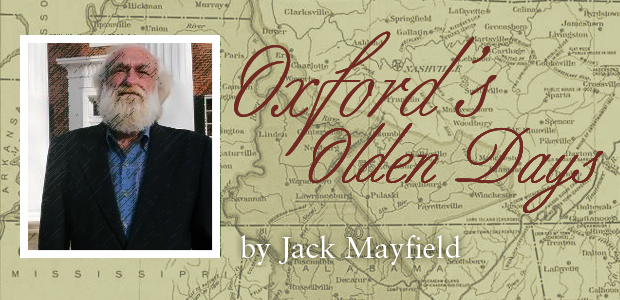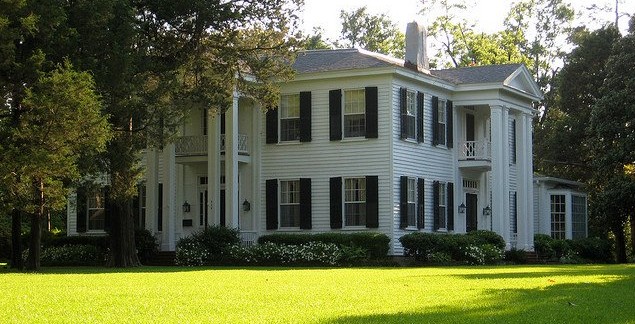Uncategorized
Oxford Homes Immortalized in Novels: Shadowlawn
During the third annual Oxford Pilgrimage, two antebellum homes were added to the list of homes to be open to visitors. Being included into novels written by local Oxford writers has immortalized these two homes. The first of these homes is the subject of this week’s column. The Neilson-Culley Home, situated at 712 South 11th Street, was built in 1856 for Oxford merchant W. S. Neilson.
Neilson came to Oxford in 1836 and started a mercantile business in alog cabin on what would become the Oxford Square. In 1856 he hired Buck Spencer, a builder from the nearby town of Serapta, to build his growing family a town house in Oxford. The home was constructed in the typical Greek Revival style, as were other homes in Oxford.
The home had a few other features that other homes in Oxford did not have. Instead of a single portico there are two, each of which opened on to hallways, which converged at the center of the house forming a Maltese cross. The large lawn is bordered with cedar trees, which were probably planted by Jacob Thompson’s caretaker and landscape designer MacDonald. The cedar trees were planted on either side of the walkway leading to the home, the same as with Rowan Oak, which MacDonald had planted for Robert Sheegog.
Prior to the invasion of Oxford by Union troops in December of 1862,the home that was in front of the Neilson home on South Lamar had burned and left the home with an unobstructed view of the street. When the Union troops entered Oxford and marched down South Lamar, young Ed Neilson, who was five at the time, and his young black playmate climbed a tree in front of the home to get a better view of the Kansas Jayhawkers passing by.
As the troops passed by one of them took aim at the small black figure in the tree and fired his rifle. The young black playmate of Ed fell from the tree and was dead by the time he hit the ground. Stark Young would hear this story as a young man in Oxford and he included it in his novel So Red the Rose. J.E. “Ed” Neilson never forgot that day as long as he lived and would relate the story to his children and grandchildren.
When Mississippi seceded from the Union, W.S. Neilson used his considerable wealth to outfit Confederate troops. Also when one of his older sons and his nephew enlisted, he provided each of them a personal body servant to take off to war with them. At this time the war effort was, at least at the beginning, going to be a gentlemen’s affair. However by December of 1862, when Union troops entered Oxford for the first time, the war had become anything but a gentleman’s war.
After the war Neilson’s priority became his business ventures. The old Neilson Store had been burned along with the other businesses on the Square, save one. Most his former slaves, who remained on his plantation outside of Oxford, wanted to remain in the service of Neilson. He gave each one a $20 gold piece and offered to furnish them a home, tools, stock and feed for the stock, and at harvest they would split the yield. Knowing that he would be fair with them, many accepted the offer and remained on the Neilson plantation. A new store was constructed on the Square shortly after the war and he was back in the mercantile business.
Young Ed Neilson would come into business with his father. In 1897 the current Neilson Department Store building was constructed on the eastside of the Square. The name was also changed to the J. E. Neilson Company. One thing that should be said is that Ed Neilson married one of the five daughters, Belle, of Hermann Wohlleben who was said to have stolen the Union payroll during Van Dorn’s raid on Holly Springs.
After the deaths of W.S. Neilson and his wife, two of his daughters remained in the Neilson home. The daughters, Miss Anna and Miss Lou, remained in the home until their deaths. Miss Lou taught china painting in her studio on the second floor of the mansion. They were also known for the annual commencement party they gave for the young people, especially the young ladies, who were not permitted to attend the rather decadent regular University commencement parties.
The home passed from the Neilson family to Dr. J. C. Culley after the deaths of Miss Anna and Miss Lou At the time of the Oxford Pilgrimage in 1966, Roland and Leah Adams owned the home. The Adams totally renovated the home and it became quite a show place. At this time it was also given the name Shadowlawn because of the shadows that the large cedar trees caused on the lawn of the home. Today the home is owned by Will and Patty Lewis who also own the J.E. Neilson Department Store, which is the oldest department store in the South and the sixteenth oldest store in the United States.
Next week the other home, the Thompson-Chandler Home or the Compson House, that has been immortalized in Faulkner’s novels.
 [dhr]
[dhr]Read more about Shadowlawn from fellow Oxford historian John Cofield here.
[dhr]
 Jack Lamar Mayfield is a fifth generation Oxonian, whose family came to Oxford shortly after the Chickasaw Cession of 1832, and he is the third generation of his family to graduate from the University of Mississippi. He is a former insurance company executive and history instructor at Marshall Academy in Holly Springs, South Panola High School in Batesvile and the Oxford campus of Northwest Community College.
Jack Lamar Mayfield is a fifth generation Oxonian, whose family came to Oxford shortly after the Chickasaw Cession of 1832, and he is the third generation of his family to graduate from the University of Mississippi. He is a former insurance company executive and history instructor at Marshall Academy in Holly Springs, South Panola High School in Batesvile and the Oxford campus of Northwest Community College.In addition to his weekly blog in HottyToddy.com Oxford’s Olden Days, Mayfield is also the author of an Images of America series book titled Oxford and Ole Miss published in 2008 for the Oxford-Lafayette County Heritage Foundation. The Foundation is responsible for restoring the post-Civil War home of famed Mississippi statesman, L.Q.C. Lamar and is now restoring the Burns Belfry, the first African American Church in Oxford.

































oakley sunglasses firefighter discount
March 24, 2015 at 10:27 am
please